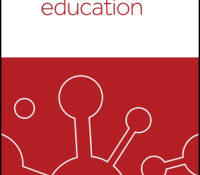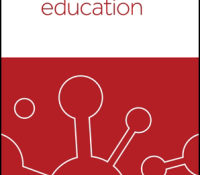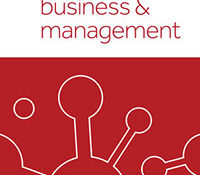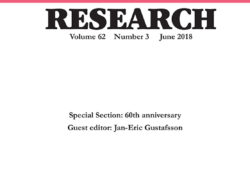eric.ed.gov har udgivet: The current study aims to perform the adaptation of the Encouragement of Academic Skills of Young Children (EASYC) Scale into Turkish. The study group was determined by means of the convenience sampling technique. A total of 124 students aged at 48-84 months were included in the sampling of the study. The data collection tools of the study are the Turkish Version of Encouragement of Academic Skills of Young Children Scale (ÇEABD) and the Home Literacy Activities Questionnaire used for criterion validity. In the analysis of the data, explanatory and confirmatory factor analyses, Pearson correlation analysis, descriptive analysis, item total correlation, and internal consistency coefficient calculation were used. As a result of the study, the ÇEABD was proved to be valid and reliable scale in the Turkish sampling.… Continue Reading →
Like this:
Like Loading...
tandfonline.com har udgivet en rapport under søgningen „Teacher Education Mathematics‟: Abstract Abstract During the last few decades, motivation to learn English has become an interesting research area. However, the studies on EFL teachers’ motivations for choosing teaching as their career, to the present date, are scanty. The present study was an attempt to construct and validate a teaching motivation scale for EFL teachers. In the qualitative results phase, the main motivations for selecting teaching were extracted and categorized into motivational types: intrinsic and extrinsic. Results of quantitative phase showed that the developed method enjoyed an acceptable construct validity. The findings can be used by teacher trainers and organizations involved in recruiting EFL teachers. Link til kilde
Like this:
Like Loading...
eric.ed.gov har udgivet: Anxiety becomes one of the psychological symptoms that can appear in every student while solving mathematics problems. Anxiety cannot be denied to be one factor that affects students‛ learning outcomes and interest in mathematics. Therefore, teachers should concern on this matter in order to decide the appropriate learning strategy. However, there is no instrument to measure the level of students‛ anxiety towards mathematics, especially for junior high school students. For that reason, this research aims to: (1) design the construct of math anxiety scale instrument; and (2) find out the validity of the instrument. This research used Research and Development method to develop and validate the product which is in the form of a questionnaire. The analysis techniques used V Aiken for content validity, EFA for construct… Continue Reading →
Like this:
Like Loading...
tandfonline.com har udgivet en rapport under søgningen „Teacher Education Mathematics‟: Abstract Abstract This study aimed to examine the psychometric characteristics of the Arabic version of the Teacher Efficacy for Inclusive Practices (TEIP) scale. Data were collected from 432 participants in Saudi Arabia—185 in-service and 247 pre-service teachers. A statistical analysis was conducted using the following methods: Confirmatory Factor Analysis (CFA), Exploratory Factor Analysis (EFA), misfit analysis via Rasch modelling, and reliability Cronbach’s alpha coefficients. Good internal consistency coefficients were obtained for the TEIP scale and each of its three subscales (>.8). Acceptable fit indices were obtained from the confirmatory factor analysis (CFA) for a scale with 18 items in three subscales: inclusive instructions, collaboration, and managing behaviour. In conclusion, the Arabic version of the TEIP scale is valid with Arabic… Continue Reading →
Like this:
Like Loading...
tandfonline.com har udgivet en rapport under søgningen „Teacher Education Mathematics‟: Abstract Formulae display:?Mathematical formulae have been encoded as MathML and are displayed in this HTML version using MathJax in order to improve their display. Uncheck the box to turn MathJax off. This feature requires Javascript. Click on a formula to zoom. Abstract A new twenty-first century skills framework and a 19-item scale was developed to bridge the gap between science and practice. A self-reporting 19-item scale was developed to measure twenty-first century skills of faculty and non-faculty staff of agri varsities. A total of 49 items were generated using deduction approach for four skills: communication and collaboration, leadership and responsibility, problem-solving and decision-making, and creativity and innovation. Two content validity techniques were used that reduced the number of items to… Continue Reading →
Like this:
Like Loading...
eric.ed.gov har udgivet: This study represents the implementation of an English version of the Mathematics Teaching Anxiety Scale (MTAS), originally published in Turkey (Sari, 2014). One hundred and twenty-seven primary school teachers from across the U.K. completed the survey, including 74 qualified teachers and 53 trainees. Following item-reduction and factor analysis, the 19-item MTAS was found to have excellent internal consistency ([alpha] = 0.94) and has a two-factor structure. Factor one, labelled Self-Directed Mathematics Teaching Anxiety, includes 12 items pertaining to a teacher’s own teaching practice and perceived ability, whereas factor two, labelled Pupil/Student-Directed Mathematics Teaching Anxiety, includes 7 items pertaining to anxiety concerning pupils/students failing assessments or not reaching curriculum/school targets. Pre-service teachers, compared to in-service teachers, self-reported significantly higher overall maths teaching anxiety. Among in-service teachers, there was… Continue Reading →
Like this:
Like Loading...
tandfonline.com har udgivet en rapport under søgningen „Teacher Education Mathematics‟: Link til kilde
Like this:
Like Loading...
eric.ed.gov har udgivet: The purpose of the research is to develop a valid and reliable attitude scale that can measure the attitudes of math and science teachers (315) and teacher candidates (105) towards mistakes and instant feedback. In the validity studies, the exploratory factor analysis was made with the SPS1S 8.0 package program after that the confirmatory factor analysis was made with Lisrel 8.8 software. To develop the scale; 1. Creation of Item Pool, 2. Obtaining Expert Opinion, 3. Creation of Pre-Trial Form, 4. Factor Analysis is made. According to factor analysis; Kaiser Meyer Olkin (KMO) rate; 0.808; Bartlett test result: 2148,354; Cronbach alpha reliability coefficient for the whole scale: 0.829. According to confirmatory factor analysis: Root Mean Square Error of Approximation (RMSEA) 0.022 (<0.05); p-Value for Test of Close… Continue Reading →
Like this:
Like Loading...
eric.ed.gov har udgivet: This paper reports on a design-based implementation study of the use of a diagnostic classroom assessment tool framed on learning trajectories (LTs) for middle grades mathematics, where teachers and students are provided immediate data on students‛ progress along LTs. The study answers the question: „How can one characterize the challenges encountered when a school implements a diagnostic assessment system around learning trajectories at scale?‟ by identifying three explanatory themes: shifting to classroom assessment, understanding the concept and content of the LT, and seeing the results as a call to action. Each theme is discussed with references to observed activities and discussions with participants and related to the challenges connected with taking the concept of LTs to scale. [For the complete proceedings, see ED606556.] Link til kilde
Like this:
Like Loading...
tandfonline.com har udgivet en rapport under søgningen „Teacher Education Mathematics‟: Abstract Abstract Nolan and Temple Lang’s Computing in the Statistics Curricula (2010) advocated for a shift in statistical education to broadly include computing. In the time since, individuals with training in both computing and statistics have become increasingly employable in the burgeoning data science field. In response, universities have developed new courses and programs to meet the growing demand for data science education. To address this demand we created Data Science in Practice, a large-enrollment undergraduate course. Here, we present our goals for teaching this course, including: (1) conceptualizing data science as creative problem solving, with a focus on project-based learning, (2) prioritizing practical application, teaching and using standardized tools and best practices, and (3) scaling education through coursework that… Continue Reading →
Like this:
Like Loading...




